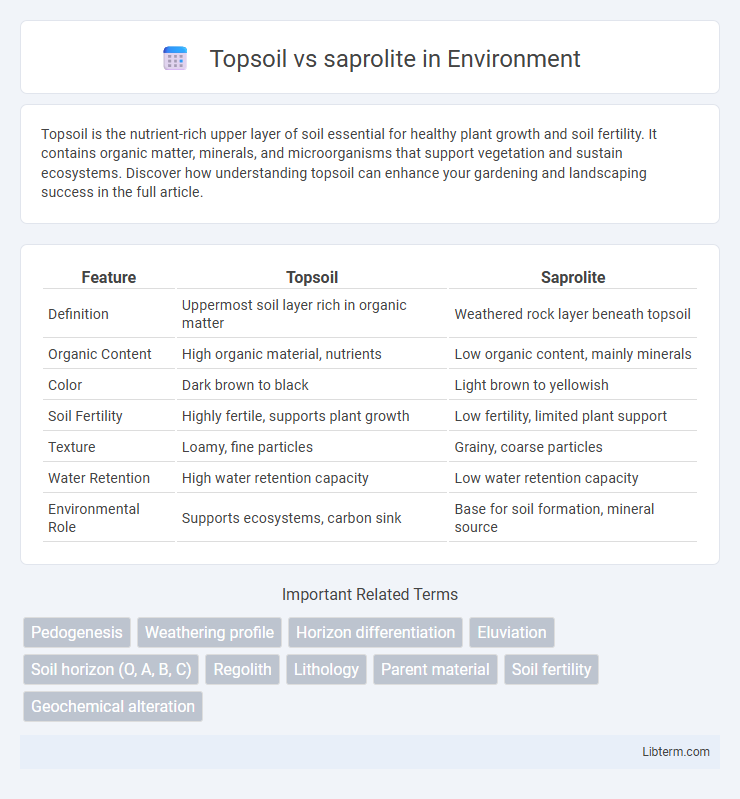Topsoil is the nutrient-rich upper layer of soil essential for healthy plant growth and soil fertility. It contains organic matter, minerals, and microorganisms that support vegetation and sustain ecosystems. Discover how understanding topsoil can enhance your gardening and landscaping success in the full article.
Table of Comparison
| Feature | Topsoil | Saprolite |
|---|---|---|
| Definition | Uppermost soil layer rich in organic matter | Weathered rock layer beneath topsoil |
| Organic Content | High organic material, nutrients | Low organic content, mainly minerals |
| Color | Dark brown to black | Light brown to yellowish |
| Soil Fertility | Highly fertile, supports plant growth | Low fertility, limited plant support |
| Texture | Loamy, fine particles | Grainy, coarse particles |
| Water Retention | High water retention capacity | Low water retention capacity |
| Environmental Role | Supports ecosystems, carbon sink | Base for soil formation, mineral source |
Understanding Topsoil and Saprolite
Topsoil is the uppermost layer of soil rich in organic matter and nutrients, essential for plant growth and agricultural productivity. Saprolite, found beneath topsoil, consists of weathered rock retaining its original structure but is less fertile and serves as a transitional layer between soil and unweathered bedrock. Understanding the differences between topsoil and saprolite is crucial for effective land management, construction, and environmental conservation.
Composition Differences
Topsoil consists primarily of organic matter, minerals, and microorganisms, making it rich in nutrients essential for plant growth, while saprolite is predominantly composed of weathered rock fragments and lacks significant organic content. The high clay and iron oxide content in saprolite contrasts with the loamy texture and humus presence typical in topsoil. These compositional differences impact water retention, fertility, and suitability for agriculture, with topsoil being more conducive to productive land use.
Formation Processes
Topsoil forms through the decomposition of organic matter and the weathering of underlying rock, creating a nutrient-rich, biologically active layer essential for plant growth. Saprolite develops from the in-situ chemical weathering of bedrock, where minerals break down but the original rock structure remains intact, resulting in a porous, friable material. Both layers reflect distinct weathering intensity and biological activity, with topsoil representing active surface processes and saprolite indicating deeper, prolonged alteration of the parent rock.
Physical Properties Comparison
Topsoil exhibits higher organic matter content and greater porosity, resulting in better water retention and aeration compared to saprolite. Saprolite is characterized by a coarser texture, lower bulk density, and higher mineral content, influencing its drainage capacity and lower nutrient availability. These physical differences impact root penetration, water movement, and soil fertility management practices in agriculture and construction.
Nutrient Content and Fertility
Topsoil contains higher nutrient content and organic matter, making it significantly more fertile for plant growth compared to saprolite. Saprolite, composed mostly of weathered rock with minimal organic material, has lower cation exchange capacity and nutrient availability. Soil fertility management focuses on topsoil preservation due to its superior ability to support microbial activity and nutrient cycling essential for crops.
Role in Plant Growth
Topsoil contains essential nutrients, organic matter, and microorganisms that support root development and enhance water retention, making it crucial for healthy plant growth. Saprolite, composed primarily of weathered rock with fewer nutrients and lower biological activity, offers limited resources for plants but can affect root penetration and soil structure. Understanding the differences between topsoil and saprolite helps optimize soil management practices for improved crop yields and sustainable agriculture.
Agricultural Uses
Topsoil is rich in organic matter and nutrients, making it ideal for agriculture as it supports robust plant growth and crop yields. Saprolite, a weathered rock layer beneath topsoil, has lower fertility and poor structure, limiting its suitability for farming without significant soil amendments. Farmers often enhance saprolite with fertilizers and organic inputs to improve its agricultural productivity.
Environmental Impact
Topsoil acts as a critical medium for plant growth and supports diverse ecosystems, playing a vital role in carbon sequestration and water filtration, which mitigates soil erosion and pollution. Saprolite, being a weathered rock layer with lower nutrient content and less organic matter, has limited biological activity and offers reduced capacity for carbon storage and water retention. Disturbance of saprolite during mining or construction can increase environmental degradation risks by exposing less stable substrates to erosion and contaminant leaching.
Soil Management Practices
Effective soil management practices differentiate between topsoil and saprolite to optimize agricultural productivity. Topsoil, rich in organic matter and nutrients, requires conservation techniques such as mulching, cover cropping, and minimal tillage to maintain fertility and prevent erosion. In contrast, saprolite, characterized by low nutrient content and poor structure, benefits from amendments like lime and organic fertilizers, along with improved drainage systems to enhance root development and soil health.
Choosing Between Topsoil and Saprolite
Topsoil, rich in organic matter and nutrients, supports robust plant growth and is ideal for gardening and landscaping projects requiring fertile soil. Saprolite, a weathered rock retaining mineral content but low in organic material, is better suited for construction or as a subsoil amendment where drainage and structural stability are priorities. Selecting between topsoil and saprolite depends on intended use, soil fertility requirements, and site conditions.
Topsoil Infographic

 libterm.com
libterm.com